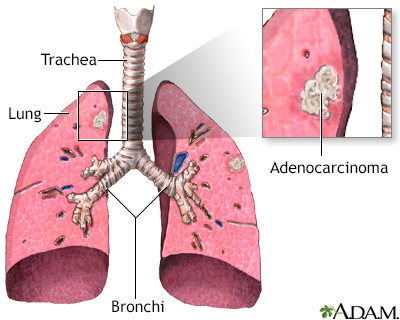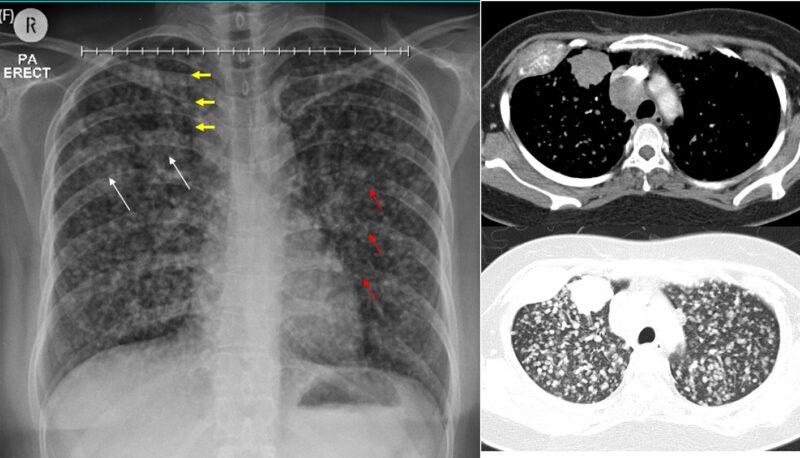
Adenocarcinoma of the Lung: What patients should know about
What is Adenocarcinoma of the Lung?
Adenocarcinoma of the lung is the most common type of lung cancer, characterized by distinct cellular and molecular features. It is a subtype of non-small cell lung cancer (NSCLC) that originates in the glandular cells lining the outer parts of the lungs and bronchi.

Source of image mountsinai.org
Causes and Risk Factors
The main cause and risk factor for adenocarcinoma of the lung is smoking tobacco. Smoking is responsible for about 90% of lung cancer cases in the UK. The risk increases with the number of cigarettes smoked per day and the number of years a person has smoked. However, adenocarcinoma of the lung is the most common type of lung cancer found in non-smokers.
Other risk factors include
- Exposure to secondhand smoke
- Exposure to radon gas, a naturally occurring radioactive gas that can build up in buildings
- Exposure to cancer-causing substances like asbestos, arsenic, chromium, and nickel, often through certain occupations
- Previous radiation therapy to the chest for other cancers
- Family history of lung cancer
- Lowered immunity due to illness or organ transplant medications
Adenocarcinoma is more common in women and younger people compared to other lung cancers.
Symptoms
- Persistent Cough: A chronic cough that may produce mucus or blood is a common early symptom of lung adenocarcinoma. The cough may worsen over time and persist despite treatment for other conditions like bronchitis or pneumonia.
- Shortness of Breath: As the tumor grows and affects lung function, individuals with lung adenocarcinoma may experience difficulty breathing, especially during physical activity or exertion. This symptom can progress as the cancer advances.
- Chest Pain: Lung adenocarcinoma can cause chest pain that may be sharp, dull, or persistent. The pain may worsen with deep breathing, coughing, or laughing, and can be located in the chest, shoulder, or back.
- Coughing up Blood: Hemoptysis, or coughing up blood or bloody sputum, is a concerning symptom that may indicate lung adenocarcinoma. It is essential to seek medical attention if this occurs.
- Weight Loss and Fatigue: Unexplained weight loss, loss of appetite, and persistent fatigue are common symptoms of lung adenocarcinoma. These symptoms can be indicative of the body’s response to the cancer and its impact on overall health.
- Other Symptoms: Additional symptoms may include hoarseness, wheezing, recurrent respiratory infections, difficulty swallowing, finger clubbing, swelling of the face or neck, and persistent chest or shoulder pain. These symptoms can vary in intensity and presentation depending on the individual and the stage of the cancer.
Early detection and prompt medical evaluation of these symptoms are crucial for timely diagnosis and treatment of lung adenocarcinoma. If you experience any of these symptoms, it is important to consult a healthcare provider for further assessment and appropriate management.
Diagnosis
The diagnosis of lung adenocarcinoma involves a series of diagnostic tests to confirm the presence of cancer.
These tests include:
- Physical Examination and Medical History: A doctor will conduct a physical examination and gather personal and family health history, inquiring about symptoms and potential risk factors like smoking or carcinogen exposure.
- Imaging Tests: Imaging tools such as X-rays, CT scans, and MRI scans are used to screen for abnormal masses in the lungs and to visualize the area of concern more clearly

Source of image radiologycases.my
- Sputum Cytology: A lab test where a sample of sputum is examined for cancer cells by a pathologist
- Thoracentesis: Involves extracting a fluid sample from between the lung and chest lining for examination by a pathologist to detect cancerous cells
- Biopsy: If lung cancer is suspected, a small sample of lung tissue is removed and examined by a pathologist. Biopsies can be obtained through methods like needle biopsy, bronchoscopy, mediastinoscopy, video-assisted thoracoscopy, or wedge resection
These diagnostic tests help confirm the presence of adenocarcinoma in the lung and determine its stage, which is crucial for treatment decisions and prognosis. Staging is based on the cancer’s location, spread, and aggressiveness, guiding the aggressiveness of treatment.
Treatment
The treatment of lung adenocarcinoma depends on the stage and location of the cancer. The most common treatment options include:
Surgery
- Surgery is often the first treatment for early-stage lung adenocarcinoma that has not spread to other parts of the body.
- The type of surgery depends on the size and location of the tumor and may involve removing a lobe (lobectomy), a segment (segmentectomy), or the entire lung (pneumonectomy)
- Surgery may be followed by chemotherapy to kill any remaining cancer cells
Radiation Therapy
- Radiation therapy uses high-energy particles or waves to destroy cancer cells.
- It may be used alone or combined with chemotherapy for advanced lung adenocarcinoma that cannot be removed with surgery.
- Stereotactic body radiotherapy (SBRT) is an intense radiation treatment that aims beams of radiation from many angles at the cancer.
Chemotherapy
- Chemotherapy is a common treatment for lung adenocarcinoma, especially in cases where the cancer is incurable or advanced.
- Platinum-based regimens are the mainstay of chemotherapy for lung adenocarcinoma, despite the challenges in significantly improving survival rates.
Chemotherapy Staging
- Chemotherapy is used across different stages of lung adenocarcinoma, from early to advanced stages, depending on the extent of the disease and the patient’s condition
- Different stages of lung adenocarcinoma, from in situ to metastatic disease, may require varying approaches to chemotherapy
Chemotherapy Complications
- Chemotherapy for lung adenocarcinoma can lead to various complications, including pancytopenia, infections, hyponatremia, renal failure, and peripheral neuropathy
- Complications from chemotherapy can impact the patient’s quality of life and require careful management by healthcare providers
Chemotherapy Drugs
- Chemotherapy drugs used for lung adenocarcinoma include platinum agents like cisplatin or carboplatin, as well as other chemotherapeutic drugs like paclitaxel, gemcitabine, docetaxel, and pemetrexed
- Newer approaches in chemotherapy, such as immunotherapy combinations and novel drug regimens, are being explored to enhance treatment outcomes for patients with lung adenocarcinoma
In summary, chemotherapy plays a significant role in the treatment of adenocarcinoma of the lung, with platinum-based regimens being commonly used across different stages of the disease. While chemotherapy can lead to complications, ongoing research is focused on improving treatment efficacy and reducing side effects through innovative drug combinations and personalized medicine approaches.
Targeted Therapy
- Targeted therapies are drugs that target specific genetic changes in cancer cells.
- They may be used alone or with chemotherapy for advanced lung adenocarcinoma with certain genetic mutations.
- Examples include EGFR* tyrosine kinase inhibitors, ALK* inhibitors, and BRAF* inhibitors.
*Mutations of these genes may result in uncontrollable cell division and cancer.
Immunotherapy
Immunotherapy has emerged as an effective treatment option for lung adenocarcinoma, particularly in the advanced stages of the disease. The most promising immunotherapy drugs for lung adenocarcinoma are checkpoint inhibitors, which work by releasing the brakes on the immune system and allowing it to recognize and attack cancer cells.
Checkpoint Inhibitors
The FDA has approved several checkpoint inhibitors for the treatment of non-small cell lung cancer (NSCLC), which includes adenocarcinoma
- PD-1 inhibitors: Nivolumab (Opdivo), Pembrolizumab (Keytruda), and Cemiplimab (Libtayo)
- PD-L1 inhibitors: Atezolizumab (Tecentriq) and Durvalumab (Imfinzi)
These drugs target the PD-1 receptor or its ligand PD-L1 in cancer cells, preventing the interaction that normally suppresses the immune response. By blocking this interaction, the immune system is better able to recognize and attack the cancer cells.
Combination Therapy
Checkpoint inhibitors can be used alone or in combination with other treatments for lung adenocarcinoma:
- With chemotherapy as the initial treatment for advanced disease
- With the CTLA-4 inhibitor ipilimumab (Yervoy)
- After chemotherapy as maintenance therapy
Prognosis and Survivorship
The prognosis, or outlook, for patients with this cancer depends on several factors, including the stage at diagnosis, overall health, and specific characteristics of the cancer. Early-stage lung adenocarcinoma has a better prognosis, with higher survival rates, while advanced stages have lower survival rates. Treatments like surgery, chemotherapy, radiation, targeted therapy, and immunotherapy can improve outcomes.
For example, patients with early-stage adenocarcinoma in situ (AIS) or minimally invasive adenocarcinoma (MIA) who undergo surgery have excellent long-term survival rates, with many living cancer-free for over ten years. However, metastatic lung adenocarcinoma, where the cancer has spread to other parts of the body, has a lower survival rate. Factors such as age, overall health, and specific genetic mutations in the cancer cells can also influence the prognosis. Newer treatments and personalized approaches are helping to improve survival rates and quality of life for many patients.
Watch Gwen’s fight story from Amgen.
Survivorship Challenges
- The fear of cancer recurrence is a major concern for lung cancer survivors
- Survivorship appointments focus on reducing the risk of recurrence through lifestyle modifications and monitoring for new lung cancers
- Other survivorship issues include managing physical side effects, maintaining quality of life, and addressing psychosocial needs
Survivorship care aims to address the unique challenges faced by lung cancer patients, including the fear of recurrence and management of long-term effects.
Physical Challenges
Reduced Cardiorespiratory Fitness
- Patients with lung cancer often have lower cardiorespiratory fitness compared to healthy individuals.
- This impairment in cardiorespiratory fitness does not improve after cancer treatments and is associated with a higher risk of complications and worse survival
Muscle Atrophy and Weakness
- Lung cancer and its treatments can lead to skeletal muscle atrophy and weakness, contributing to reduced functional capacity and quality of life
Respiratory Impairment
- The tumor, chemotherapy, radiotherapy, and surgery can all negatively impact the respiratory system, leading to reduced lung function, diffusing capacity, and alveolar hypoventilation
- This respiratory impairment contributes to the common symptom of dyspnea (shortness of breath) experienced by lung cancer patients
Fatigue and Deconditioning
- Lung cancer patients frequently experience debilitating fatigue, which can be exacerbated by the disease and its treatments
- This fatigue, combined with reduced physical activity levels, leads to overall deconditioning and impaired functional status
Other Physical Challenges
- Patients may also experience pain, insomnia, anxiety, and depression, which can further impact physical function and quality of life
In summary, the key physical challenges faced by lung adenocarcinoma patients include reduced cardiorespiratory fitness, muscle atrophy, respiratory impairment, fatigue, and deconditioning, all of which can significantly impact their daily functioning and well-being.
During Treatment
Common side effects include
During treatment for adenocarcinoma of the lung, common side effects can include:
- Breathing problems
- Fatigue
- Infection, bleeding, and anemia
- Stomach problems like nausea, vomiting, diarrhea, or constipation
- Changes in appearance, including hair loss
- Pain and discomfort
- Changes in sexual functioning and effects on fertility
- Skin conditions like dry and itchy skin
- Loss of appetite and weight changes
- Peripheral neuropathy (nerve damage)
- Cardiac toxicities leading to symptoms of heart failure
- Long-term neuropathy and hearing loss
These side effects can vary in severity and may require management and support from healthcare providers to improve the patient’s quality of life during treatment for lung adenocarcinoma.
After Treatment
Follow-up Care
Follow-up Recommendations
- Patients with early-stage (stage I-II) non-small cell lung cancer (which includes adenocarcinoma) should have follow-up visits every 6 months for the first 2-3 years, then annually.
- Patients with advanced-stage (stage III-IV) non-small cell lung cancer should have follow-up visits every 3-6 months for the first 5 years.
- Follow-up visits typically involve a physical exam, medical history, and imaging tests like CT scans of the chest.
- Patients may also undergo additional tests like brain MRI or PET/CT scans if clinically indicated.
Rationale for Follow-up
- To monitor for cancer recurrence or development of a new primary lung cancer
- To assess physical recovery and manage any long-term side effects of treatment
- To provide psychosocial support and address any concerns the patient may have
Importance of Adherence
- Patients are encouraged to adhere closely to the recommended follow-up schedule, as early detection of recurrence or new cancers can improve outcomes
- However, studies show many patients do not complete the full recommended number of follow-up CT scans
Long-term Considerations
- Survivors of lung adenocarcinoma face risks of recurrence, second primary lung cancers, and other health issues related to their cancer and treatment
- Maintaining healthy lifestyle habits, receiving recommended cancer screenings, and managing any long-term effects are important for these patients
In summary, close and regular follow-up care is crucial for patients treated for lung adenocarcinoma to monitor for recurrence, manage side effects, and support their overall health and well-being.
Resources
- American Cancer Society – Cancer.org
- National Cancer Institute – Cancer.gov
- American Society of Clinical Oncology (ASCO) – Cancer.net
- Transforming lung cancer LUNGEVITY – Lungevity.org
- Canadian Cancer Society – Cancer.ca/en
- Long-Term Prognosis of Patients With Resected Adenocarcinoma In Situ and Minimally Invasive Adenocarcinoma of the Lung – PubMed
- Johns Hopkins Medicine -Hopkinsmedicine.org
- Cancer Research Institute – cancerresearch.org
- American Lung Association – www.lung.org
- Oncodaily.com
-
Challenging the Status Quo in Colorectal Cancer 2024
December 6-8, 2024
-
ESMO 2024 Congress
September 13-17, 2024
-
ASCO Annual Meeting
May 30 - June 4, 2024
-
Yvonne Award 2024
May 31, 2024
-
OncoThon 2024, Online
Feb. 15, 2024
-
Global Summit on War & Cancer 2023, Online
Dec. 14-16, 2023
